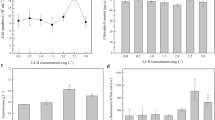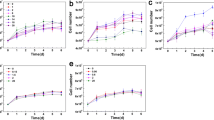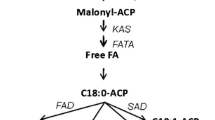Abstract
Cultivation is the most expensive step in the production of biodiesel from microalgae, and substantial research has been devoted to developing more cost-effective cultivation methods. Plant hormones (phytohormones) are chemical messengers that regulate various aspects of growth and development and are typically active at very low concentrations. In this study, we investigated the effect of different phytohormones on microalgal growth and biodiesel production in Chlamydomonas reinhardtii and their potential to lower the overall cost of commercial biofuel production. The results indicated that all five of the tested phytohormones (indole-3-acetic acid, gibberellic acid, kinetin, 1-triacontanol, and abscisic acid) promoted microalgal growth. In particular, hormone treatment increased biomass production by 54 to 69 % relative to the control growth medium (Tris–acetate–phosphate, TAP). Phytohormone treatments also affected microalgal cell morphology but had no effect on the yields of fatty acid methyl esters (FAMEs) as a percent of biomass. We also tested the effect of these phytohormones on microalgal growth in nitrogen-limited media by supplementation in the early stationary phase. Maximum cell densities after addition of phytohormones were higher than in TAP medium, even when the nitrogen source was reduced to 40 % of that in TAP medium. Taken together, our results indicate that phytohormones significantly increased microalgal growth, particularly in nitrogen-limited media, and have potential for use in the development of efficient microalgal cultivation for biofuel production.






Similar content being viewed by others
References
Brune, D., Lundquist, T., & Benemann, J. (2009). Microalgal biomass for greenhouse gas reductions: potential for replacement of fossil fuels and animal feeds. Journal of Environmental Engineering, 135, 1136–44.
Demirbas, A. (2009). Progress and recent trends in biodiesel fuels. Energy Conversion and Management, 50, 14–34.
Gouveia, L., & Oliveira, A. (2009). Microalgae as a raw material for biofuels production. Journal of Industrial Microbiology & Biotechnology, 36, 269–74.
Harun, R., Davidson, M., Doyle, M., Gopiraj, R., Danquah, M., & Forde, G. (2011). Technoeconomic analysis of an integrated microalgae photobioreactor, biodiesel and biogas production facility. Biomass and Bioenergy, 35, 741–7.
Hu, B., Min, M., Zhou, W. G., Li, Y. C., Mohr, M., et al. (2012). Influence of exogenous CO2 on biomass and lipid accumulation of microalgae Auxenochlorella protothecoides cultivated in concentrated municipal wastewater. Applied Biochemistry and Biotechnology, 166, 1661–73.
Liu, J. H., Yuan, C., Hu, G. R., & Li, F. L. (2012). Effects of light intensity on the growth and lipid accumulation of Microalga Scenedesmus sp 11–1 under nitrogen limitation. Applied Biochemistry and Biotechnology, 166, 2127–37.
Sheng, J., Kim, H. W., Badalamenti, J. P., Zhou, C., Sridharakrishnan, S., et al. (2011). Effects of temperature shifts on growth rate and lipid characteristics of Synechocystis sp. PCC6803 in a bench-top photobioreactor. Bioresource Technology, 102, 11218–25.
Zheng, Y., Chi, Z., Lucker, B., & Chen, S. (2012). Two-stage heterotrophic and phototrophic culture strategy for algal biomass and lipid production. Bioresource Technology, 103, 484–8.
Pruvost, J., Cornet, J. F., & Legrand, J. (2008). Hydrodynamics influence on light conversion in photobioreactors: an energetically consistent analysis. Chemical Engineering Science, 63, 3679–94.
Carvalho, A., Silva, S., Baptista, J., & Malcata, F. (2011). Light requirements in microalgal photobioreactors: an overview of biophotonic aspects. Applied Microbiology and Biotechnology, 89, 1275–88.
Chen, C.-Y., Yeh, K.-L., Aisyah, R., Lee, D.-J., & Chang, J.-S. (2011). Cultivation, photobioreactor design and harvesting of microalgae for biodiesel production: a critical review. Bioresource Technology, 102, 71–81.
Rubio, V., Bustos, R., Irigoyen, M. L., Cardona-Lopez, X., Rojas-Triana, M., & Paz-Ares, J. (2009). Plant hormones and nutrient signaling. Plant Molecular Biology, 69, 361–73.
Chatterjee, S., Chatterjee, S., Chatterjee, B. P., & Guha, A. K. (2008). Enhancement of growth and chitosan production by Rhizopus oryzae in whey medium by plant growth hormones. International Journal of Biological Macromolecules, 42, 120–6.
Vance, B. D. (1987). Phytohormone effects on cell division in Chlorella pyrenoidosa chick (TX-7-11-05) (chlorellaceae). Journal of Plant Growth Regulation, 5, 169–73.
Czerpak, R., Bajguz, A., Gromek, M., Kozłowska, G., & Nowak, I. (2002). Activity of salicylic acid on the growth and biochemism of Chlorella vulgaris Beijerinck. Acta Physiologiae Plantarum, 24, 45–52.
Tate, J., Gutierrez-Wing, M. T., Rusch, K., & Benton, M. (2013). The effects of plant growth substances and mixed cultures on growth and metabolite production of green algae Chlorella sp.: a review. Journal of Plant Growth Regulation, 32, 417–28.
Piotrowska, A., Czerpak, R., Pietryczuk, A., Olesiewicz, A., & Wędołowska, M. (2008). The effect of indomethacin on the growth and metabolism of green alga Chlorella vulgaris Beijerinck. Plant Growth Regulation, 55, 125–36.
Hunt, R. W., Chinnasamy, S., Bhatnagar, A., & Das, K. C. (2010). Effect of biochemical stimulants on biomass productivity and metabolite content of the microalga, Chlorella sorokiniana. Applied Biochemistry and Biotechnology, 162, 2400–14.
Yoshida, K., Igarashi, E., Mukai, M., Hirata, K., & Miyamoto, K. (2003). Induction of tolerance to oxidative stress in the green alga, Chlamydomonas reinhardtii, by abscisic acid. Plant, Cell & Environment, 26, 451–7.
Ludwig-Müller, J. (2011). Auxin conjugates: their role for plant development and in the evolution of land plants. Journal of Experimental Botany, 62, 1757–73.
Tarakhovskaya, E. R., Maslov, Y. I., & Shishova, M. F. (2007). Phytohormones in algae. Russian Journal of Plant Physiology, 54, 163–70.
Kiseleva, A. A., Tarachovskaya, E. R., & Shishova, M. F. (2012). Biosynthesis of phytohormones in algae. Russian Journal of Plant Physiology, 59, 595–610.
Gorman, D. S., & Levine, R. P. (1965). Cytochrome f and plastocyanin: their sequence in the photosynthetic electron transport chain of Chlamydomonas reinhardtii. Proceedings of the National Academy of Sciences, 54, 1665–9.
Ritchie, R. J. (2006). Consistent sets of spectrophotometric chlorophyll equations for acetone, methanol and ethanol solvents. Photosynthesis Research, 89, 27–41.
Brányiková, I., Maršálková, B., Doucha, J., Brányik, T., Bišová, K., et al. (2011). Microalgae—novel highly efficient starch producers. Biotechnology and Bioengineering, 108, 766–76.
Folch, J., Lees, M., & Stanley, G. H. S. (1957). A simple method for the isolation and purification of total lipides from animal tissues. Journal of Biological Chemistry, 226, 497.
De-Bashan, L. E., Antoun, H., & Bashan, Y. (2008). Involvement of indole-3-acetic acid produced by the growth-promoting bacterium Azospirillum spp. in promoting growth of Chlorella vulgaris1. Journal of Phycology, 44, 938–47.
Gonzalez, L. E., & Bashan, Y. (2000). Increased growth of the microalga Chlorella vulgaris when coimmobilized and cocultured in alginate beads with the plant-growth-promoting bacterium Azospirillum brasilense. Applied and Environmental Microbiology, 66, 1527–31.
Shibaoka, H. (1994). Plant hormone-induced changes in the orientation of cortical microtubules: alterations in the cross-linking between microtubules and the plasma membrane. Annual Review of Plant Physiology and Plant Molecular Biology, 45, 527–44.
Matsumura, K., Yagi, T., Hattori, A., Soloviev, M., & Yasuda, K. (2010). Using single cell cultivation system for on-chip monitoring of the interdivision timer in Chlamydomonas reinhardtii cell cycle. Journal of Nanobiotechnology, 8, 1–13.
Lee, K., & Lee, C.-G. (2001). Effect of light/dark cycles on wastewater treatments by microalgae. Biotechnology and Bioprocess Engineering, 6, 194–9.
Amaro, H. M., Guedes, A. C., & Malcata, F. X. (2011). Advances and perspectives in using microalgae to produce biodiesel. Applied Energy, 88, 3402–10.
Illman, A. M., Scragg, A. H., & Shales, S. W. (2000). Increase in Chlorella strains calorific values when grown in low nitrogen medium. Enzyme and Microbial Technology, 27, 631–5.
Author information
Authors and Affiliations
Corresponding authors
Rights and permissions
About this article
Cite this article
Park, WK., Yoo, G., Moon, M. et al. Phytohormone Supplementation Significantly Increases Growth of Chlamydomonas reinhardtii Cultivated for Biodiesel Production. Appl Biochem Biotechnol 171, 1128–1142 (2013). https://doi.org/10.1007/s12010-013-0386-9
Received:
Accepted:
Published:
Issue Date:
DOI: https://doi.org/10.1007/s12010-013-0386-9




